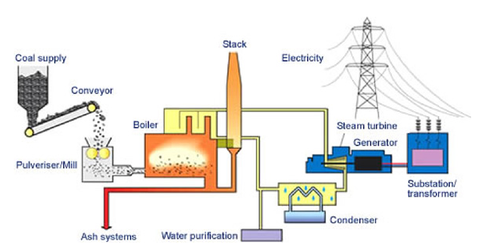Industry structure analysis: Coal-fired power generation equipment
Coal (KOL) has fired much of the development in the US and other OECD economies in the 20th century. It’s firing growth in economies like China and India.
Jan. 14 2015, Updated 2:05 p.m. ET

Coal-fired power plants
As we touched upon in earlier parts in this series, electricity is generated in conventional thermal power plants using steam. Coal or natural gas is burned inside boilers at a very high temperature. Pipes filled with water are lined up against the walls of the boilers. As the coal and natural gas burns, the water in these pipes transforms into steam. The steam spins turbines, which in turn drive electricity generation.
While the boiler, turbine, and generator (collectively referred to as “BTG”) are the most important parts of a power plant, you shouldn’t overlook the importance of other components. Precipitators control the emissions of pollutants and ash, condensers and water cooling systems convert the steam back into water to reuse it in the boiler, and ash systems store ash.
Key markets
Conventional thermal power plants are the largest source of electricity in the world, with a market share of around 65%. Coal (KOL) has fired much of the development in the US and other OECD economies in the 20th century. In a similar fashion, coal is firing growth in economies like China and India. In the US, fossil fuels account for 68% of electricity generation, while in China, they account for 78%. In terms of capacity, China has the largest conventional thermal capacity at 900 gigawatts or GW (mostly fired by coal), followed by the US at 823 GW (41% coal, 59% natural gas). Japan was a distant third with capacity of 189 GW, followed by India at 168 GW. The entire European Union had conventional thermal capacity of 500 GW.
Global players
While China holds the largest coal-fired power capacity, the market is dominated by Chinese companies like Dongfang Electric and Harbin Electric. GE Energy (GE) and Siemens are major global players in the industry. GE is a part of the SPDR Industrial Sector ETF (XLI) along with other electrical equipment manufacturers like Emerson Electric (EMR) and Eaton (ETN).
What are the key issues facing conventional thermal power generation equipment manufacturers? Find out in the next part of this series.
